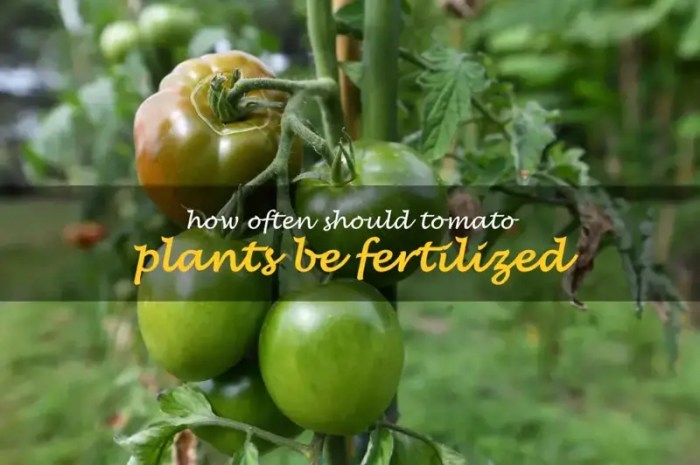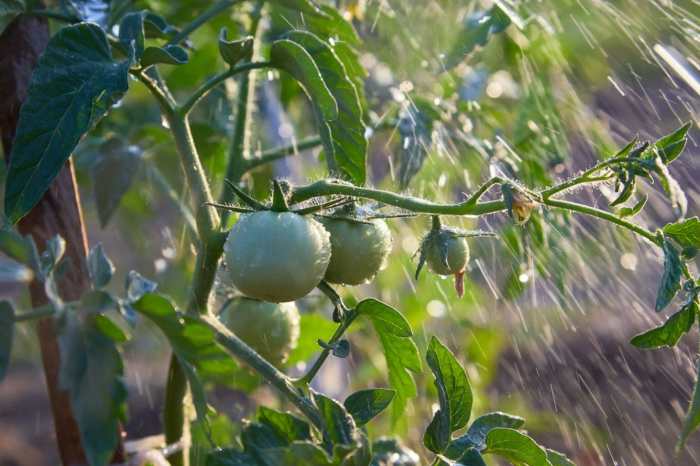How Often Should You Water Tomato Plants
Factors Affecting Watering Frequency
How often should you water tomato plants – The frequency with which you water your tomato plants depends on several interacting factors. Understanding these factors is crucial for maintaining healthy, productive plants. Consistent watering is key, but overwatering or underwatering can lead to significant problems.
Soil Type and Water Retention
Different soil types retain varying amounts of water. Sandy soils, for example, drain quickly and require more frequent watering. Clay soils, on the other hand, retain water well and may need watering less often. Loamy soils, a mix of sand, silt, and clay, offer a good balance of drainage and water retention.
- Sandy Soil: Excellent drainage, but dries out quickly, requiring frequent watering.
- Clay Soil: Poor drainage, retains water for extended periods, leading to potential overwatering issues.
- Loamy Soil: Ideal soil type for tomatoes, offering good drainage and water retention.
Weather Conditions and Watering Adjustments

Source: shuncy.com
Sunlight, temperature, and rainfall significantly impact a tomato plant’s water needs. Hot, sunny days with low rainfall will necessitate more frequent watering, while cooler, cloudy days with rainfall may require less.
| Temperature (°C) | Sunlight Hours | Rainfall (mm) | Suggested Watering Frequency |
|---|---|---|---|
| >30 | >8 | <5 | Daily or every other day |
| 25-30 | 6-8 | 5-10 | Every 2-3 days |
| 20-25 | 4-6 | 10-15 | Every 3-4 days |
| <20 | <4 | >15 | Every 4-5 days or less |
Plant Size and Growth Stage
Watering needs change as the plant grows. Seedlings require less water than young plants, which in turn need less than mature plants. The image below illustrates this concept.
Visual Representation: Imagine three images side-by-side. The first shows a small seedling in a small pot, requiring only a small amount of water to keep the soil moist. The second depicts a young tomato plant, slightly larger, in a larger pot, needing more water to sustain its growth. The third image shows a mature, large tomato plant, requiring significantly more water to support its extensive root system and fruit production.
The difference in water volume needed is clearly visible between the three images.
Watering Methods and Techniques
Several methods exist for watering tomato plants, each with its advantages and disadvantages. Selecting the right method depends on factors like garden size, budget, and personal preference.
Comparison of Watering Methods
| Watering Method | Water Efficiency | Cost | Ease of Use |
|---|---|---|---|
| Drip Irrigation | High | Moderate | Moderate |
| Soaker Hoses | High | Low | Easy |
| Hand Watering | Low | Low | Easy |
Hand Watering Technique
When hand watering, it’s crucial to water deeply at the base of the plant to avoid wetting the foliage, which can promote fungal diseases. This prevents water from splashing onto the leaves, creating a humid environment conducive to fungal growth.
- Use a watering can with a gentle rose.
- Water slowly and deeply, allowing the water to penetrate the soil.
- Ensure the soil is thoroughly moistened to a depth of several inches.
- Avoid wetting the leaves and stems.
Mulching Benefits and Drawbacks
Mulching around tomato plants helps conserve soil moisture, suppress weeds, and regulate soil temperature. However, improper mulching can also lead to certain issues.
- Benefits: Reduced water evaporation, suppressed weed growth, improved soil temperature regulation, enhanced soil health.
- Drawbacks: Potential for attracting pests or diseases if mulch is not properly maintained, may hinder air circulation around the base of the plant if applied too thickly.
Signs of Underwatering and Overwatering

Source: growyouryard.com
Recognizing the signs of underwatering and overwatering is vital for maintaining healthy tomato plants. Early detection allows for timely corrective action.
Signs of Underwatered Tomato Plants
Underwatered tomato plants exhibit several telltale signs. Wilting is a common symptom, often accompanied by leaf discoloration and drooping.
Visual Representation: Imagine a picture showing a tomato plant with droopy, wilted leaves. The leaves may appear curled or rolled, and their color might be dull or slightly grayish-green instead of a vibrant green. The soil around the base of the plant would be visibly dry and cracked.
Signs of Overwatered Tomato Plants, How often should you water tomato plants
Overwatering can lead to yellowing leaves, stunted growth, and eventually root rot. Root rot is a serious condition that can kill the plant.
Visual Representation: The image would depict a tomato plant with yellowing leaves and possibly some brown, mushy areas on the stem near the soil line. The roots, if visible, would appear brown and mushy instead of healthy white or light brown.
Root Rot Image Description: The image shows the roots of a tomato plant that are dark brown or black, mushy, and slimy. Healthy roots are typically white or light brown and firm.
Diagnosing Watering Problems
Checking soil moisture is the most reliable way to diagnose watering problems. A simple finger test can provide a quick assessment.
- Insert your index finger about an inch into the soil.
- If the soil feels dry, it’s time to water.
- If the soil feels moist, wait before watering again.
Maintaining Soil Health for Optimal Watering
Healthy soil is essential for efficient watering and optimal tomato growth. Proper soil drainage and the use of soil amendments are crucial.
Soil Drainage and Improvement
Good soil drainage prevents waterlogging, which can suffocate roots. If your soil drains poorly, you can improve it by incorporating organic matter such as compost or aged manure.
Improving soil drainage might involve adding organic matter like compost to improve soil structure, or even amending the soil with perlite or vermiculite to increase aeration.
Benefits of Soil Amendments
Soil amendments improve soil structure, water retention, and nutrient availability. Compost is a particularly beneficial amendment.
- Compost: Improves soil structure, water retention, and nutrient content.
- Aged Manure: Adds nutrients and improves soil structure.
- Perlite/Vermiculite: Improves aeration and drainage.
Creating a Well-Draining Container Mix
For container-grown tomatoes, a well-draining mix is crucial. A suitable mix typically includes a combination of potting soil, perlite, and compost.
Container Mix Recipe: A good ratio might be 2 parts potting mix, 1 part perlite, and 1 part compost. Adjust the ratio based on the specific potting mix and desired drainage.
Answers to Common Questions: How Often Should You Water Tomato Plants
What type of water is best for tomato plants?
Use lukewarm water whenever possible to avoid shocking the roots. Avoid using water directly from a cold tap.
Should I water my tomatoes in the morning or evening?
Watering in the morning is generally preferred as it allows the foliage to dry before nightfall, reducing the risk of fungal diseases.
How can I tell if my tomato plants have root rot?
Root rot often manifests as wilting despite moist soil. You may also notice a foul odor emanating from the soil. Inspecting the roots will reveal brown, mushy tissue.
My tomato leaves are curling. Is this due to watering?
Leaf curling can indicate both underwatering and overwatering. Check the soil moisture and look for other symptoms to pinpoint the cause.




















